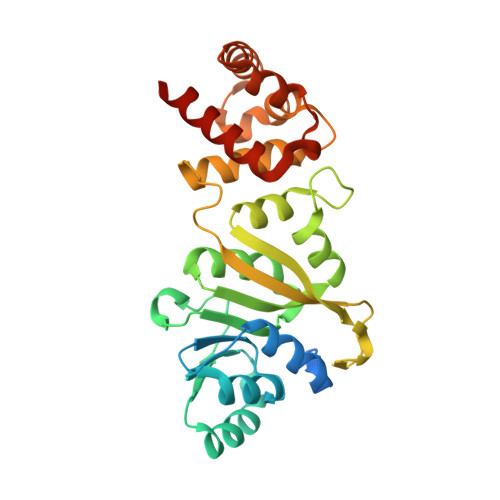Binding of adenosine-based ligands to the MjDim1 rRNA methyltransferase: implications for reaction mechanism and drug design.
O'Farrell, H.C., Musayev, F.N., Scarsdale, J.N., Rife, J.P.(2010) Biochemistry 49: 2697-2704
- PubMed: 20163168
- DOI: https://doi.org/10.1021/bi901875x
- Primary Citation of Related Structures:
3GRR, 3GRU, 3GRV, 3GRY - PubMed Abstract:
The KsgA/Dim1 family of proteins is intimately involved in ribosome biogenesis in all organisms. These enzymes share the common function of dimethylating two adenosine residues near the 3'-OH end of the small subunit rRNA; orthologs in the three kingdoms, along with eukaryotic organelles, have evolved additional functions in rRNA processing, ribosome assembly, and, surprisingly, transcription in mitochondria. The methyltransferase reaction is intriguingly elaborate. The enzymes can bind to naked small subunit rRNA but cannot methylate their target bases until a subset of ribosomal proteins have bound and the nascent subunit has reached a certain level of maturity. Once this threshold is reached, the enzyme must stabilize two adenosines into the active site at separate times and two methyl groups must be transferred to each adenosine, with concomitant exchanges of the product S-adenosyl-l-homocysteine and the methyl donor substrate S-adenosyl-l-methionine. A detailed molecular understanding of this mechanism is currently lacking. Structural analysis of the interactions between the enzyme and substrate will aid in this understanding. Here we present the structure of KsgA from Methanocaldococcus jannaschii in complex with several ligands, including the first structure of S-adenosyl-l-methionine bound to a KsgA/Dim1 enzyme in a catalytically productive way. We also discuss the inability thus far to determine a structure of a target adenosine bound in its active site.
- Department of Physiology and Biophysics, Virginia Commonwealth University, Richmond, Virginia 23298-0133, USA.
Organizational Affiliation:


















